Home | Front Page | Index | Blog | New | Contact | Site Map
Lake Peten Itza
Tikal
Coban
Guatemala City
Lake Atitlan
Markets
Antigua
Rio Dulce
Esquipulas
Mundo Maya
Foto Show
More About Coffee
Coban, Guatemala
San Pedro, Guatemala
Cafe Britt, Costa Rica

Central America
Route Maps
Belize
Honduras
Nicaragua
Costa Rica
Panama
Mexico 2003-04:
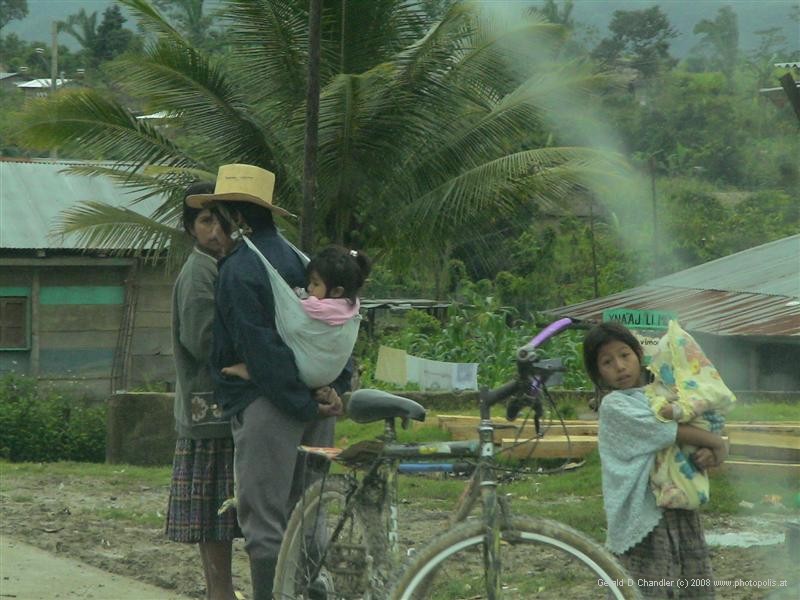
Indian Family from Alta Verapaz |
Leaving Flores, we took a tour guide's advice and drove southwest to Coban on what he said was the newly paved and best road in Guatemala, rather than taking the standard and slightly longer route via Rio Dulce to Guatemala City. Going to Ceibal we had already experienced the first part, a 20 km drive over good dirt road and then the 40 km of good paved road to Sayaxche (Sigh-yash-cheh), passing an oil field and refinery (which we think is one of the few in Guatemala). At Sayaxche instead of getting into the river boat for Ceibal, as we had two days earlier, we took a ferry across the Rio de la Pasion. The ferry boat can carry about ten cars; the ramp is a non-ramp: we had to have our car pushed off and up the steep slope in order to avoid ripping out the muffler.
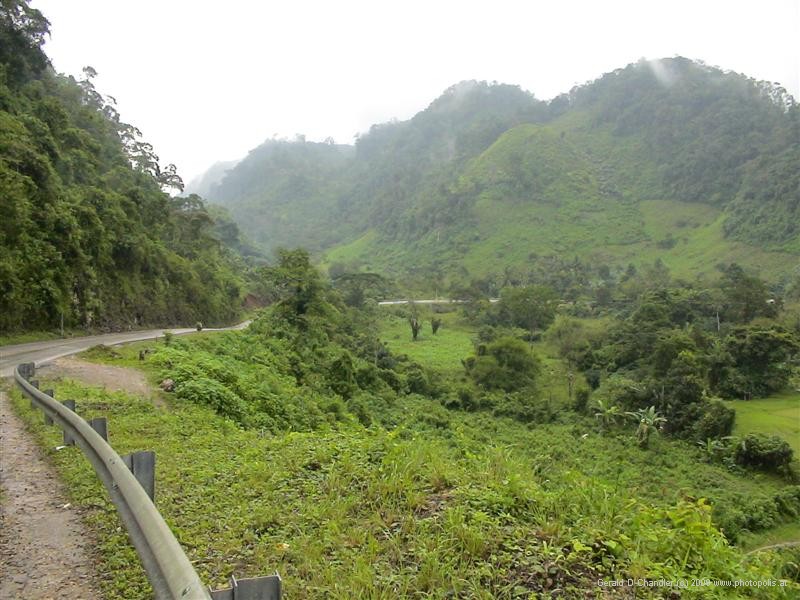
Climbing into Alta Verapaz's Mountains |
From there the road was as promised, very good. We stayed on the Peten plain another hour, with the flat terrain vaguely reminding us of our initial experience in Cambodia, even though instead of lush green rice fields we were seeing mostly uncultivated country or cattle ranching. Then the terrific road climbed up and up into the province of Alta Verapaz, its capital, Coban, and coffee country.
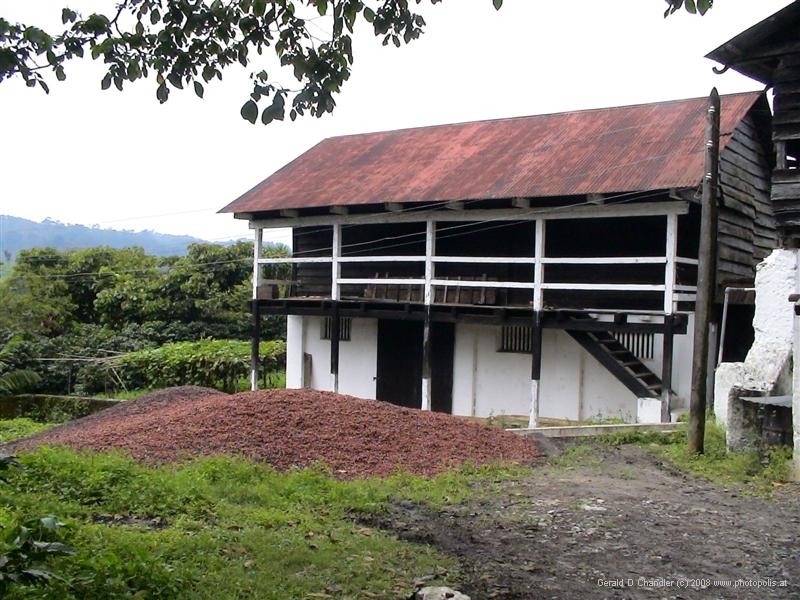
Discarded coffee parchment (outer skins) |

Coban Coffee Cherries |
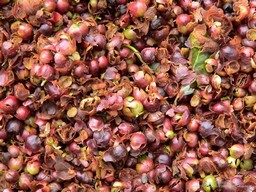
The Cherries' Outer Skins |
About 150 years ago immigrants, primarily Germans, came to this 1800 m high country and started coffee plantations or fincas as they are known here. They developed everything from scratch: cleared the fields, created roads for mule wagons to carry the produce to export, and brought western ways. We toured the Finca Santa Margarita, a coffee plantation in the heart of Coban and saw it all: the nursery for young trees, immature trees, trees with green beans too young to pick, red beans ready for picking, the areas and machines for removing the outer skin, the drying, the roasting, grinding, and bagging. The last are offered for sale to tourists. Unfortunately there are only Arabica and Robusta trees there, no Decafinata trees, so we didn't buy any.
Our time in Coban was too short to really get to know it. But we walked up the hill to the church that is a pilgrimage site and got a good view of the city. We went to the private Museo El Principe Mayo, housed in the front part of the owner's house, that impressed us for its content and display quality. We spoke to her, a very friendly, 50ish woman, and she explained that the collection was made over the years by purchases here and there. It would now be impossible to create because the Guatemalan laws are more strict: almost certainly 95% of it came from tomb robbing and today the place of origin of every item must be certified to the government. On the wall is a certificate from the government saying, in essence, that every piece on display has been accounted for and must remain accounted for.
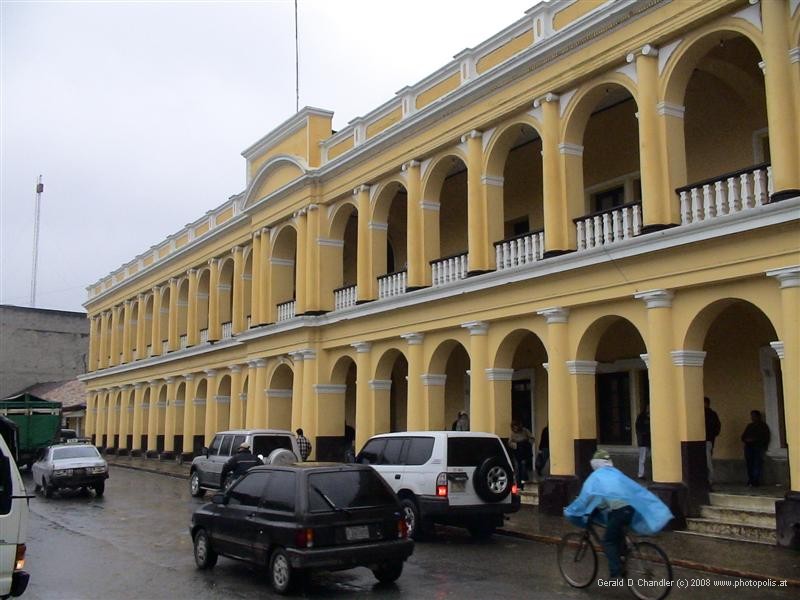
Downtown Coban |
South of Coban, according to one map 30 km and by our measure 50 km, is the Biotopo de Quetzal, a national park devoted to preservation of Quetzals, the Guatemalan national bird. Its more formal name is Biotopo Mario Dario Rivera, named for the man most instrumental in its establishment. We spent two-thirds of a day there, but as with the howlers failed to catch even a glimpse of one. Because we went in the dry season the little cascades that run through the mountain side location of the park were mostly dry. Still we had a pleasant time among the greenery, even if we were pretty slow in going around the 4 km loop, that includes ascending and then descending about 200 m.
As we were leaving Jan got into a sort conversation with the caretaker. He told her that many children could not afford to go to school. That came as a surprise since we thought that school was free through high school. It opened up a subject that we raised several times with others. It turns out that there is no tuition fee, but the children are required to have uniforms and buy their own school supplies, something many cannot afford. On a brighter note, while we were in Guatemala there was a campaign, sponsored by the government, to encourage private individuals and companies to donate pencils and other school supplies for the country's rural schools.